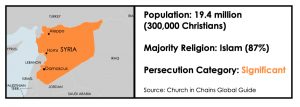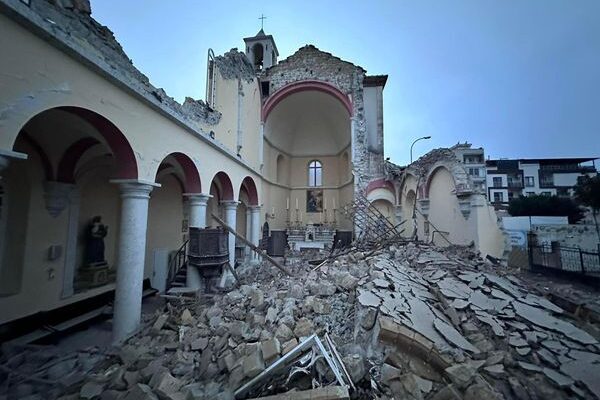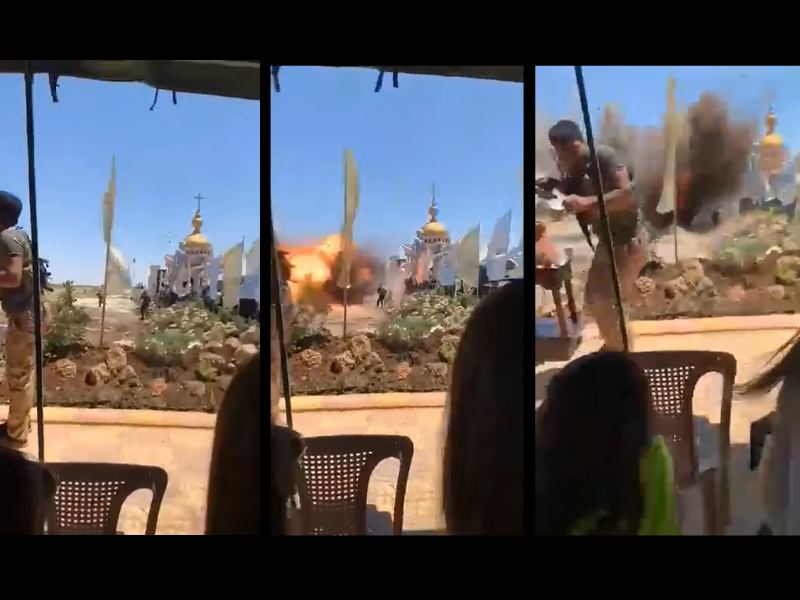
The majority of Syria’s Muslim population is Sunni, but President Bashar al-Assad and his supporters are Alawites, members of a Shi’ite sect that makes up only 12% of Syria’s population. Alawites are influential in the army and government.
Syria’s long-running civil war has turned into an effective stalemate since 2020, with President Assad’s government holding about seventy per cent of the country, Kurdish forces in control of the northeast and Turkish-backed Islamist forces in charge of parts of the north and northwest.
Since 2011, when the civil war erupted, up to 600,000 people have been killed and almost 14 million displaced, including over one million Christians. Half are internally displaced within Syria and half are outside, mainly in Lebanon, Jordan and Turkey. Despite the stalemate, the country continues to be a war zone and the whole population faces terrible hardships because of the effect of international sanctions.
The civil war grew out of the 2011 Arab Spring protest movement, when Syrians began to protest against President Assad’s Baath Party government and to demand the release of political prisoners. In March 2011 troops were ordered to fire on protestors and the ensuing unrest led to the development of an armed opposition that grew into a coalition of rebels trying to overthrow the government. By December 2015 Islamic State terrorists held an area extending from eastern Syria to western Iraq.
The Syrian Democratic Forces declared territorial defeat of Islamic State in March 2019 after retaking its territory, but the caliphate leaves a legacy of instability, ruined infrastructure, food shortages and unemployment. Pockets of IS fighters remain a threat and the situation is particularly unstable in northern Syria, which was invaded by Turkish troops in October 2019.
Christians in Syria
Christians living under government control or in the Kurdish-controlled region enjoy relative freedom – especially Orthodox and Catholic – although the small Evangelical population faces some suspicions and restrictions. The vast majority of Christians have fled the Islamist-controlled area, where most church buildings have been demolished or taken over and where it is forbidden to worship publicly.
The Syrian church dates back to New Testament times and before the civil war Syria was one of the safest places in the Arab world to be a Christian. While there was some discrimination (for instance in connection with housing and employment) and some emigration, Syrian Christians enjoyed relative freedom and stability, were prosperous, had good relations with Muslims and were respected in society. They were allowed to worship and practise their faith without much official interference and although meetings were monitored Christian literature was freely available. The Christian population was concentrated in cities, especially Damascus, and consisted mainly of Orthodox and Catholic Christians, with a small Protestant church.
During the civil war, Christians were particularly affected in areas under the control of extremist Islamists who viewed them as an obstacle to a Sharia-governed country. In these areas, widespread violence included attacks on Christians, their property and church buildings, and many Christians were kidnapped for ransom.
Almost the entire Christian population of some cities fled. Syria’s second city Aleppo, on the front line of fighting between the government, rebel forces and Islamic State for much of the war, had one of the largest pre-war Christian populations in Syria, but it dropped from 250,000 to fewer than 40,000 Christians. The Christian population of Homs, a city particularly badly affected by the war, declined from at least 60,000 to fewer than 1,000.
Why were Christians targeted?
Christians were targeted by Islamist opposition factions that wanted Syria to become a Sunni Muslim state, notably Jabhat Fatah al Sham, the al-Qaeda offshoot previously known as Jabhat al-Nusra or Nusra Front. Such extremists adopted the slogan “Alawites to the tomb and Christians to Beirut”.
Christians were widely believed by the opposition to be supporters of President Assad, since they enjoyed relative freedom and security under the rule of the secular Baath party. It and other secular parties suppressed the Muslim Brotherhood and the more radical Salafists. The belief that Christians were pro-government meant they were very vulnerable in areas controlled by opposition groups. Furthermore, many radical fundamentalists come from poor rural communities and urban slums and targeted Christians because of their perceived prosperity.
(Barnabas Fund, BBC, Christian Post, Irish Times, Middle East Concern, Morning Star News, Open Doors, Operation World, Reuters, RTE, Tear Fund, UN, Voice of the Martyrs Canada, World Watch List, World Watch Monitor)
Church in Chains in Action
During the civil war period, Church in Chains supported a number of aid projects working with partner organisations including Barnabas Fund (providing aid to displaced Christians within the country), Asia Link (providing for the needs of Syrian Christian refugees in neighbouring countries) and Team Hope (supporting a Christian doctor ministering in Aleppo).
TURKEY/SYRIA: Christians among those suffering from earthquake

Calls for prayer for all involved in the aid effort
SYRIA: Two killed in drone attack during church inauguration

Two people were killed and twelve were injured in a drone attack during the opening ceremony of a new church building on Sunday 24 July
